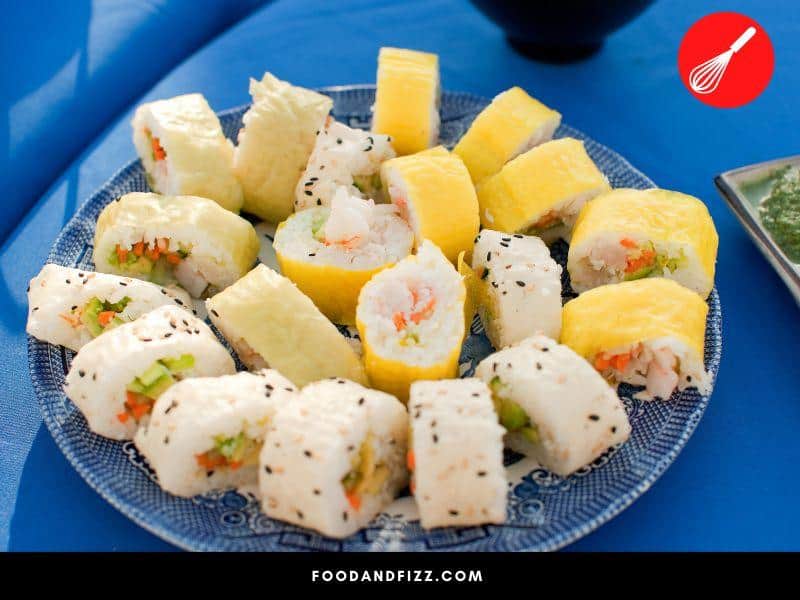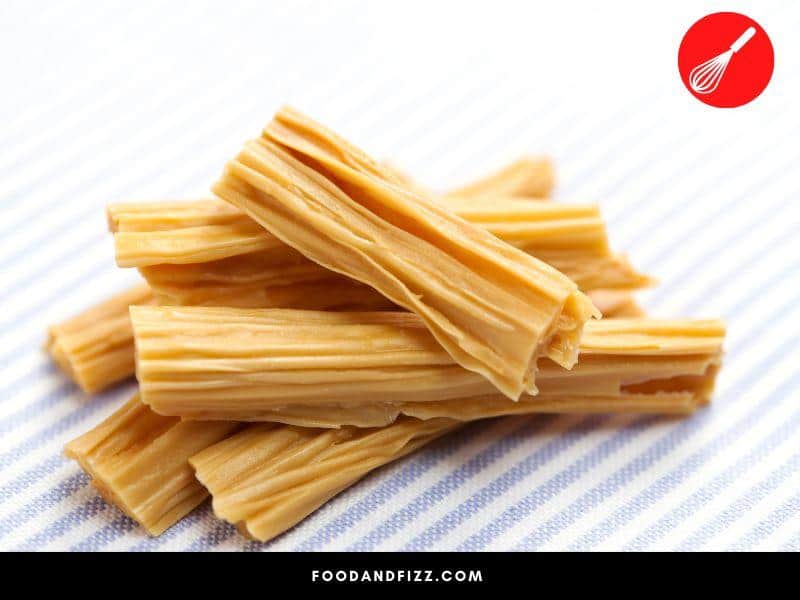When we think of dried seaweed, or nori, as they are called in Japanese, we immediately think of sushi. Aside from contributing to the classic flavor of sushi, it serves a functional purpose because it helps hold all the other ingredients together, helping sushi maintain its form.
But is seaweed necessary for making sushi? What if you don’t like seaweed or can’t find it? Are there good alternatives to use?
How to Make Sushi Without Seaweed
You can use soybean paper, rice paper, or tofu skin as a replacement for seaweed in sushi, or you can wrap your sushi in sliced cucumber, lettuce, or shiso leaves instead. You can also make traditional sushi that doesn’t use seaweed or opt to leave it out of your recipe.

How to Make Sushi Without Seaweed – 6 Ways
If you don’t like the flavor of seaweed or otherwise have to make sushi without it, there are several alternatives you can use.
1. Soybean Paper
Made from compressed soybeans and other ingredients depending on the brand, soy paper is an excellent alternative to seaweed for sushi. It is known as “Mame nori” in Japan, and is used in many sushi restaurants to create attractive and imaginative sushi rolls.
Its use is not just limited to sushi and can be used in appetizers, wraps, and even desserts. The taste of soybean paper is neutral, making it the perfect backdrop or accompaniment to your sushi should you wish to explore bolder flavors and textures. They are also gluten-free.
Unlike nori which has a very specific flavor profile, soybean paper doesn’t have a strong flavor and can offer you the opportunity to explore your creative cooking side.
Soybean wrappers also come in many different colors and patterns which can up your sushi game, aesthetics-wise. Who doesn’t love cute sushi?

2. Rice paper
Rice paper is a great alternative to seaweed for sushi. It has a mild, almost tasteless flavor and won’t distract from the flavors of your sushi.
It is easy to work with, can be sourced easily as it is available in most grocery stores, and it can be used to make other dishes too, such as Vietnamese-style spring rolls. It is actually used to make Japanese fresh spring rolls, called Nama Harumaki.
Rice paper varies in thickness, so make sure you find something that is not too thick that it changes the texture of your sushi or too thin that it cannot hold all your fillings together.
Rice paper can be made from 100% rice flour or it can be mixed with other ingredients like tapioca flour, which affects its thickness, consistency, and pliability.
Before using, it is typically soaked in water to soften it for use. Rice paper is a staple in many Asian cuisines and can be successfully used as a substitute for seaweed in holding your sushi together.
3. Tofu Skin or Yuba
When soymilk is heated, proteins and fats rise to the top, and a thin yellowish film forms on its surface. When this film is extracted and air-dried, we get what is called “yuba”.
Yuba or beancurd skin is a healthy, protein-rich food that is commonly found in Chinese and Japanese cuisine.
It can be used as a topping for various dishes, as an ingredient in soups and stir-fries, and even enjoyed on its own with some soy sauce, ginger, and wasabi, as in sashimi. It is sometimes also made into noodles.
Due to its mild flavor, yuba is very versatile and can be used in many different ways. Its use in vegetarian cooking as a meat replacement is remarkable.
I’ve seen it made into a vegetarian duck or chicken, and I’ve personally made vegan bacon with it. The possibilities are really endless!
It can be used to replace seaweed as a wrapper for your sushi rolls. The flavor profile and texture may change a bit, but that’s not really a bad thing.
You can try to make traditional sushi with it in place of seaweed, or try these vegan yuba rolls.

4. Cucumber
Another way to make sushi without seaweed is to use cucumber. Simply slice your cucumber into thin strips using a vegetable peeler or mandolin, or if you don’t have one, you can slice them as thin as you can using a knife.
Pat the cucumber slices with a towel to absorb excess moisture, add the fillings inside, and beginning from one side, roll it into a spiral until you reach the other end. Voila! Cucumber sushi roll!
5. Lettuce or Shiso Leaves
You can also use lettuce or shiso leaves (Japanese basil) to make sushi without seaweed. For shiso leaves, the shape of the leaves might make it a little bit trickier to completely wrap your fillings but it should work out if you carefully wrap them.
For lettuce, the best type to use in my opinion is Romaine lettuce. Simply cut away the tough white center, lay them out on strips on your bamboo rolling mat, and proceed to add the rice and fillings, and roll them as you would sushi with seaweed.

6. Leave It Out
And finally, you can make sushi without seaweed by simply leaving it out of your recipe. You can make what some cooks call “ghost rolls”, or sushi rolls that do not make use of seaweed or nori.
They look just like your regular maki rolls and are made and rolled in the same way. Just make sure that you press your rice with a little bit more pressure than normal as this is what will hold your rolls together rather than an external covering.
A bamboo mat and plastic wrap, and the right amount of pressure to ensure that it will hold together will help you do this successfully.
You can also opt to make other types of sushi that do not have seaweed in them, such as sashimi, nigiri, or even a chirashi bowl, which is essentially a sushi rice bowl, and just leave out the seaweed topping.
Another type of sushi called inari is made with deep-fried tofu pockets and does not contain nori or seaweed. You can also make your sushi in this way.
So there you have it, 6 ways to make sushi without using any seaweed. While nori or seaweed is deeply associated and integrated into the art of sushi making, there are other substitutes that you can use if you find that you are out, or if you simply do not enjoy it.
What is Nori or Seaweed in Sushi?
Nori is the green or black paper-like ingredient that is used to wrap sushi or is used as a thin ribbon to hold your sushi together. It is made from red algae that are dried and processed.
It has an umami flavor and can have a fishy smell and taste as it is from the sea. It is widely used in Japanese and Korean cuisine, and you will most likely encounter it in sushi or gimbap in Korea.
Some people do not enjoy the taste of nori, but some people believe it is an integral part of an authentic sushi experience, as much as sushi rice itself.
Other Types of Sushi With No Seaweed
There are a few types of sushi that do not feature nori. We’ll look at some of them below.
Sashimi
Sashimi is usually thinly sliced raw seafood that is served as is. It does not have the traditional vinegared sushi rice associated with sushi, and does not have seaweed or nori in it as well.
Tamagoyaki
Tamagoyaki is a cooked Japanese omelet that is composed of many layers of eggs that are rolled together. It is typically served as thick slices, without rice, as in sashimi.
Nigiri
Nigiri is typically raw or cooked seafood served on top of rice, with or without a ribbon of seaweed around it. If you cannot have nori, request a nigiri without the seaweed ribbon around it.
Inari
Inari is also a type of sushi that is seaweed-free. Instead of a sheet of seaweed holding it together, inari is a type of sushi with deep-fried tofu pouches as its base.
Chirashi
Chirashi sushi is essentially a sushi bowl, “deconstructed sushi” if you will.
It is easy to put together and is in a form that makes it easy to add or leave out ingredients that you do not wish to have in your dish. Nori or seaweed here just usually features as a topping, and can easily be left out of the recipe.
Read Also: 8 Types of Sushi Without Seaweed

Frequently Asked Questions on How to Make Sushi Without Seaweed
What is Ghost Roll Sushi?
Ghost roll sushi is sushi that is rolled and made without the use of the traditional seaweed or nori outside to hold the ingredients. For it to work, the rice must be packed firmly and shaped properly to hold the ingredients together.
What Can I Substitute for Dried Seaweed in Sushi?
If you cannot have dried seaweed, you can use soy or rice paper, tofu skin, lettuce or shiso leaves, cucumbers, or just leave it out of your recipe.
Can You Find Sushi Without Seaweed?
There are types of sushi that do not use seaweed as an ingredient, such as sashimi, tamagoyaki, certain types of nigiri, inari, and chirashi.
Conclusion to How to Make Sushi Without Seaweed
While seaweed is an iconic ingredient in sushi, it is possible to enjoy sushi without it. Using substitutes like soy or rice paper, tofu skin, cucumber, or lettuce leaves, you can still create sushi that’s delicious and enjoyable and fits your specific taste and dietary requirements.

